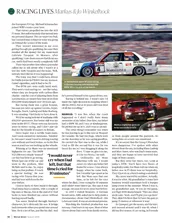Fledgling journalist Norbert Haug was keen to help push a driver from the Stuttgart area and was to become a close friend. “It wasn’t just a relationship between a journalist and a race driver,” says the current Mercedes Formula 1 boss. “He came very often to my office in the morning to talk motorsport. We did some motocross together, skiing, driving cars in the snow — a lot of crazy stuff! He was a wild animal, hugely competitive. If you played darts with him, you could forget it if he did not win. But he was a really genuine and very positive guy.”
From virtually nowhere Winkelhock found himself in competition not just with his fellow juniors, but also the BMW ‘senior’ team of Ronnie Peterson and Hans Stuck. At a training camp in St Moritz, Marc and Manfred beat the Swedish ace in a cross-country ski race. “Manfred could not breathe,” recalls Surer. “But he turned around to Ronnie and said, ‘This is how it’s going to be in the future!”
BMW’s Paul Rosche became a huge fan and in 1978 he pushed Winkelhock into the works March Formula Two team. The step to single-seaters was an enormous one. Nevertheless he was fifth first time out at Thruxton and finished the year with a third at Hockenheim. “He was a touring car driver, so he was driving too hard and destroying the tyres,” says Surer. “He had a difficult time but wouldn’t give in, so he crashed with everybody!”

F1 debut came with Arrows in 1980
Hoch Zwei/Corbis via Getty Images
He also had to adjust to a new life living in England, staying initially with veteran journalist Alan Brinton in Sevenoaks. Out of the cockpit he always seemed to get into scrapes. He lost his German driving licence after a road-rage incident involving a leading politician. Manfred took umbrage to being overtaken by a convoy of limos that paid no heed to a solid white line, so he repassed them and conducted a brake test.
Brinton helped him get a UK licence, but he put that at risk too. After a Goodwood test Winkelhock and Surer travelled to Southampton in their company 320s. When they made a wrong turn into the docks Manfred didn’t think twice about nudging the Swiss down a ramp and into the sea. “I got out through the roof,” smiles Marc. “We pulled it out, and of course it wouldn’t start. Later we got it going, although maybe only on two cylinders! I told BMW I had a misfire and needed a new car. It smelled like fish…”








